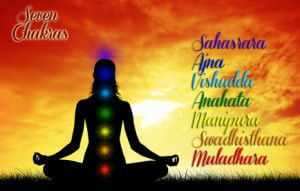An Ancient System of Energy-Chakra Meditation

The practice of chakra meditation comes from the Tantric tradition, which arose during the second half of the first millenium, A.D. However, the concept of chakras is much older. In the ancient IndianVedas (1,500 – 500 B.C.), the original meaning of chakra is ‘wheel,’ which in these texts refers to the chariot wheels of the rulers, as well as a metaphor for the sun itself.
The Yoga Upanishads (c. 600 B.C.) talk about chakras as psychic centers of consciousness, as do theYoga Sutras of Patanjali (c. 200 B.C.). The Yoga Sutras describe a balance between pure consciousness and the prime material of the world, and imply that yoga’s goal is to rise above nature in order to experience pure consciousness.
These traditions and texts describe seven basic, major chakras (though there is discussion of minor chakras throughout the body). The seven chakras are said to exist within the metaphysical body, which overlays the physical body, creating an energy field around us.
The truly fascinating thing about the seven chakras is that modern physiology has found that they correspond exactly to the seven main nerve ganglia emanating from the spinal column.
Through chakra meditation, one can let go of these ‘stuck energies’ so that energy can flow freely through the chakras once more. As each chakra is related to the organs, cells and body systems it surrounds, releasing the negative energies contributes to the well-being of these areas.
For the purposes of visualization, each of the seven chakras is associated with a color, although each person experiences their own chakras differently. The following is an overview of the associations surrounding the chakras, although the specifics vary depending on each individual.
Crown Chakra: Located at the very top of the head, the crown chakra is associated with our connection to a higher power, living in the present moment and inspiration; our connection to the universe as a whole. It is linked to the color purple, and pure white light.
Third Eye Chakra: Also known as the brow chakra, the third eye chakra is located in the center of the forehead. It is the chakra of higher perspective, wisdom, intelligence and intuition, and is associated with the color indigo.
Throat Chakra: Located at the base of the throat, this chakra is linked to decision making, self-responsibility, inner authority, living and speaking with authenticity and expressing our creativity. The throat chakra is linked to the color blue.
Heart Chakra: The heart chakra is located in the center of the chest, and is the center of love, compassion, trust and confidence. It is associated with the colors green and pink.
Solar Plexus Chakra: The solar plexus stretches from just below the heart chakra down to the navel. It is linked to our self esteem, ego, sense of individuality, and sense of personal power, and is aligned with the color yellow.
Sacral Chakra: The sacral chakra is found just below the navel, and is associated with our inner child, and spontaneous, creative expression. It is linked to the color orange.
Root Chakra: The root chakra is located at the very base of the spine, and relates to to our most primal instincts, including our sexuality. It is also linked to our connection with the earth and with others, as well as our physical groundedness. The root chakra is traditionally visualized using the color red.
when energies are observed with a neutral, open perspective, any negativity and blockages will clear spontaneously, through being allowed to ‘let go.’ When all chakras are aligned, they work harmoniously with each other, and balance our entire energy field into a synergistic whole, with all energies working as one towards the goal of well-being.

Leave a Reply
Want to join the discussion?Feel free to contribute!